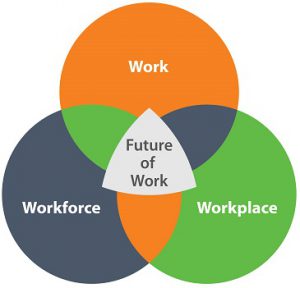Rising to the Challenges and Opportunities Presented by the Future of Work: NIOSH Introduces its Future of Work Initiative
Posted on by The future of work is influenced by many changes to workplace, work, and workforce factors such as organizational design, work arrangements, technological job displacement, artificial intelligence, robotics, technologies, demographics, economic security, and skills. Advances in the future of work offer many opportunities, but they also create challenges for the workplace and work, with consequences for the safety, health, and well‐being of the workforce.
The future of work is influenced by many changes to workplace, work, and workforce factors such as organizational design, work arrangements, technological job displacement, artificial intelligence, robotics, technologies, demographics, economic security, and skills. Advances in the future of work offer many opportunities, but they also create challenges for the workplace and work, with consequences for the safety, health, and well‐being of the workforce.
Holistic workplace and work programs, policies, and practices to ensure the safety, health, and well-being of the workforce and the employers who employ them are not new (1, 2). The scientific literature is filled with evidence on the importance of future of work issues such as paid leave (3-7), job flexibility (8), adequate living wages (9-11), job stability (12, 13), and healthy leadership (14) to not only meet workers’ basic needs, but also that of their families, communities, and society. What is new, however, is awareness of the significance and necessity of these issues and their impact on the ability of the workplace, work, and workforce to thrive, simply subsist, or vanish in today’s world.
To address this, in 2019, NIOSH launched the Future of Work Initiative, which applies the Total Worker Health® approach to encourage collaboration across the spectrum of organizational policies, programs, and practices. This is a collective effort of multidisciplinary research, communication, and partnerships throughout NIOSH, other government agencies, and organizations that aims to identify novel research solutions, practical approaches, and stakeholder opportunities to address the future of work. A foundational activity included introducing a set of priority topics and subtopics to serve as a guiding framework for NIOSH research and practice‐based activities (15).

The COVID-19 pandemic has demonstrated the need for a renewed focus on future of work issues today and moving forward. NIOSH and other occupational safety and health stakeholders can lead the way in understanding the implications of future of work scenarios and translating effective interventions into practice for employers safeguarding the safety, health, and well‐being of their workforce. By instituting recommendations identified by the NIOSH Future of Work Initiative and other similar efforts, we can shape a tomorrow that has the potential to create a future workforce that is the safest and healthiest of any, to date.
The future of work continues to evolve. Please provide your recommendations on what its vision should include, in the comment section below.
Click here to read the NIOSH Future of Work Initiative’s foundational paper.
Sara L. Tamers, PhD, MPH, is Coordinator of the NIOSH Future of Work Initiative, Coordinator of Total Worker Health® Program, and Assistant Coordinator of Healthy Work Design and Well-Being Program.
John Howard, MD, is the Director of the National Institute for Occupational Safety and Health.
References
- Tamers SL, Chosewood LC, Childress A, Hudson H, Nigam J, Chang CC. Total Worker Health((R)) 2014(-)2018: The Novel Approach to Worker Safety, Health, and Well-Being Evolves. Int J Environ Res Public Health. 2019;16.
- National Institute for Occupational Safety and Health. Healthy Work Design and Well-Being Program: https://www.cdc.gov/niosh/programs/hwd/default.html. 2020.
- Asfaw A, Colopy M. Association between parental access to paid sick leave and children’s access to and use of healthcare services. Am J Ind Med. 2017;60:276-284.
- Asfaw A, Pana-Cryan R, Rosa R. Paid sick leave and nonfatal occupational injuries. Am J Public Health. 2012;102:e59-64.
- Asfaw A, Rosa R, Pana-Cryan R. Potential Economic Benefits of Paid Sick Leave in Reducing Absenteeism Related to the Spread of Influenza-Like Illness. J Occup Environ Med. 2017;59:822-829.
- Baker M, Milligan K. Maternal employment, breastfeeding, and health: Evidence from maternity leave mandates. Journal of health economics. 2008;27:871-887.
- Bureau of Labor Statistics. National Compensation Survey: Employee benefits in the United States, March 2019: Table 31. Leave benefits: Access, civilian workers: https://www.bls.gov/ncs/ebs/benefits/2019/employee-benefits-in-the-united-states-march-2019.pdf. 2019.
- Standing G. Global labor flexibility. Seeking distributive justice. 1st ed. London: MacMillan Press Ltd.; 1999.
- Du J, Leigh JP. Effects of wages on smoking decisions of current and past smokers. Ann Epidemiol. 2015;25:575-582 e571.
- Kaufman JA, Salas-Hernández LK, Komro KA, Livingston MD. Effects of increased minimum wages by unemployment rate on suicide in the USA. Journal of epidemiology and community health. 2020;74:219-224.
- Leigh JP, Du J. Are low wages risk factors for hypertension? Eur J Public Health. 2012;22:854-859.
- Luhmann M, Schimmack U, Eid M. Stability and variability in the relationship between subjective well-being and income. Journal of Research in Personality. 2011;45:186-197.
- Schneider D, Harknett K. It’s about time: How work schedule instability matters for workers, families, and racial inequality: https://shift.berkeley.edu/files/2019/10/Its-About-Time-How-Work-Schedule-Instability-Matters-for-Workers-Families-and-Racial-Inequality.pdf. University of California Research Brief; 2019.
- Jiménez P, Winkler B, Dunkl A. Creating a healthy working environment with leadership: the concept of health-promoting leadership. The International Journal of Human Resource Management. 2017;28:2430-2448.
- Tamers SL, Streit J, Pana-Cryan R, et al. Envisioning the future of work to safeguard the safety, health, and well-being of the workforce: A perspective from the CDC’s National Institute for Occupational Safety and Health. Am J Ind Med 101002/ajim23183. 2020.
Post a Comment